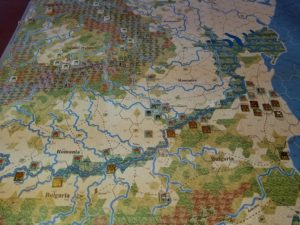Finally got around to continuing my play of Romania – The Transylvania Gambit.
As previously posted, the Romania Army’s plan was badly flawed, and the scenario certainly reflects that. The availability of German reinforcements to bolster the Austro-Hungarians effectively stops any offensive across the Carpathians.
Despite the slow operational tempo of mountain fighting and Romania’s desperate-from-the-start prospects, I was settling down for another session when a casual glance at the rule book moved the game from the possibly forgettable to another memorable rules gaffe.
Tim’s been on me to compile and post a list of our grotesque errors of rules omissions and commissions. I have consistently demurred. Not out of personal shame, but because the compilation would be a very lengthy and time consuming process. So Tim, here’s one in real time.
All those German reinforcements hustled south using the Austro-Hungarian rail network, which has a capacity of three units per turn phase. It took a few phases, but the Romanian attacks were quickly blunted. Well, that was too quickly. While the entire rail capacity is three units, the capacity for any one rail line in that network is only one unit per phase. Whoops………..
The poor Romanians were not only fighting a flawed initial deployment and the mountainous terrain, but also some very tough units that should not have been there – at least not so quickly.
Well, that put paid to the game. It was going to be some time before the operational tempo accelerated past “slog” speed, especially with Winter just around the turn track corner. My current impatience is not the best mood to enjoy a scenario which accurately represents the time and resources required to build up combat power in this theater of operations.
So, despite my high regard for the system, I decided to pack it up, and move on to another game.
Here’s a photo taken right before it all went back in the box. Note all those gray German units in the North Central portion of the map.
